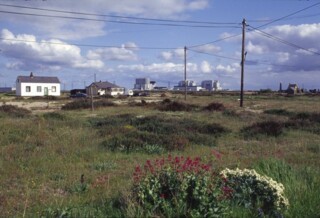Nuclear Landscapes
Gillian Darley
The modernist mantra that form follows function is best suited to industrial buildings. Even the great cooling towers of coal-fired power stations, visible for miles around like the funnels of land-locked ocean liners, can be celebrated as functional architecture. But the inscrutable form of the nuclear power plant gives nothing away. The events at Fukushima are a terrifying reminder of what those innocuous-looking boxes actually contain.
As a child on holiday in the Quantocks, I remember looking down from the moors towards the Bristol Channel and seeing the incongruous, blocky form of Hinkley Point A in the distance. On the east coast, closer to home, Sizewell was a dour counterpoint to the eccentric holiday village of Thorpeness. In the mid 1980s I attended one day of the interminable Sizewell B public enquiry – it ran for almost three years, taking the record for the longest planning enquiry ever. (One of the other journalists there had just returned from the Philippines, where a new nuclear power plant had been given the go-ahead after a public consultation that lasted three days.) Frank Layfield eventually found in favour of the new Pressurised Water Reactor: Sizewell B was built between 1987 and 1995. The latest generation of nuclear power stations have the letter C – it brings hurricanes to mind.
Buildings the size of nuclear power stations would normally only be easily accommodated within a city, or on its fringes, but for obvious reasons they have to be built as far as possible from populated areas, and beside large bodies of water. So, in Britain at least, that means in isolated places of natural beauty. The first fire at a UK nuclear reactor took place in 1957, at Windscale (later rebranded Sellafield), with a prevailing westerly blowing towards the Lake District.
The first generation of British nuclear power stations has been retired. Dungeness A, Sizewell A and Hinkley Point A are all beached whales: the last stage in the decommissioning process is currently scheduled for 2110. They will not, unlike sound mirrors or the detritus of Second World War defence systems, become weird and wonderful objects in the landscape. At best, they provide a sense of scale, as at Dungeness (see the picture above). Elsewhere, the immense structures provide welcome new habitats. The Bradwell-on-Sea plant, in the flatlands of the Dengie peninsular in Essex, was decommissioned in 2002. Its cliff-like walls are now nesting grounds for peregrine falcons.

Comments